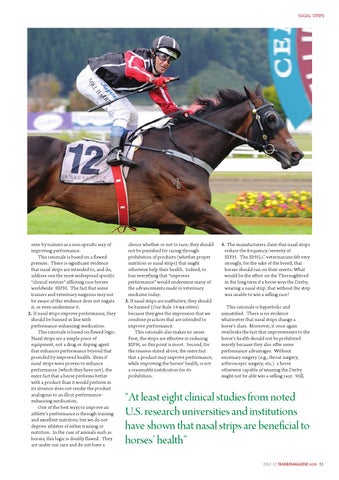letter issue 32.qxd:Jerkins feature.qxd
26/11/10
17:20
Page 2
NASAL STRIPS
seen by trainers as a non-specific way of improving performance. This rationale is based on a flawed premise. There is significant evidence that nasal strips are intended to, and do, address one the most widespread specific “clinical entities” afflicting race horses worldwide: EIPH. The fact that some trainers and veterinary surgeons may not be aware of this evidence does not negate it, or even undermine it. 2. If nasal strips improve performance, they should be banned in line with performance-enhancing medication. This rationale is based on flawed logic. Nasal strips are a simple piece of equipment, not a drug or doping agent that enhances performance beyond that provided by improved health. Even if nasal strips were proven to enhance performance (which they have not), the mere fact that a horse performs better with a product than it would perform in its absence does not render the product analogous to an illicit performanceenhancing medication. One of the best ways to improve an athlete’s performance is through training and excellent nutrition; but we do not deprive athletes of either training or nutrition. In the case of animals such as horses, this logic is doubly flawed. They are under our care and do not have a
choice whether or not to race; they should not be punished for racing through prohibition of products (whether proper nutrition or nasal strips) that might otherwise help their health. Indeed, to ban everything that “improves performance” would undermine many of the advancements made in veterinary medicine today. 3. If nasal strips are ineffective, they should be banned (Our Rule 14 xix refers) because they give the impression that we condone practices that are intended to improve performance. This rationale also makes no sense. First, the strips are effective in reducing EIPH, so this point is moot. Second, for the reasons stated above, the mere fact that a product may improve performance, while improving the horses’ health, is not a reasonable justification for its prohibition.
4. The manufacturers claim that nasal strips reduce the frequency/severity of EIPH. The EHSLC veterinarians felt very strongly, for the sake of the breed, that horses should run on their merits. What would be the effect on the Thoroughbred in the long term if a horse won the Derby, wearing a nasal strip, that without the strip was unable to win a selling race? This rationale is hyperbolic and unjustified. There is no evidence whatsoever that nasal strips change a horse’s class. Moreover, it once again overlooks the fact that improvements to the horse’s health should not be prohibited merely because they also offer some performance advantages. Without necessary surgery (e.g., throat surgery, arthroscopic surgery, etc,) a horse otherwise capable of winning the Derby might not be able win a selling race. Still,
“At least eight clinical studies from noted U.S. research universities and institutions have shown that nasal strips are beneficial to horses’ health” ISSUE 32 TRAINERMAGAZINE.com 53
